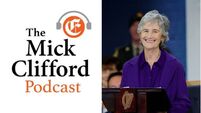Fianna Fáil is at the edge of a cliff and in mortal danger
If the eclipse of the North as a major current issue is a tribute to its success, economic decimation is the ebola virus that is eating Fianna Fáil’s flesh away
ASWIFT end is sometimes better than survival in a calamity. Fianna Fáil’s fate has been to survive after the greatest electoral calamity since the old Irish Party’s 1918 obliteration. Tonight, its first ard fheis in opposition since 1997 begins. Back then, an election was imminent and hope was high. Now, if it is lucky, it faces a decade of hard work reclaiming credibility. That labour has been made immeasurably greater by Éamon Ó Cuív.
Just as the party was poised to attempt a new conversation with the Irish people, Ó Cuív ambushed again. Previously his issue was whether the party should run a candidate for the presidency. Now his latent scruples about European policy erupted at the most inopportune moment.
In truth, Fianna Fáil may already be in terminal decline. Of the ministers who left Leinster House on June 6, 1997, to receive their seals of office from President Mary Robinson at Áras an Uachtaráin, only Micheál Martin remains on the political stage. Éamon Ó Cuív likewise was a minister for every day of the following 14 years, albeit a junior minister for the first five. The embrace this week of the two last ministerial veterans of all of those 14 years in a duet of mutual destruction shows a party losing its once lethal instinct for survival.
There is a real question about the future relevance of Fianna Fáil. To its credit, it has a legacy of unparalleled success as a constitutional republican party. It led Ireland into Europe and ended the previously dominant and domineering Anglo-Irish axis that circumscribed Ireland’s place in the world. At home, it negotiated the Good Friday Agreement and sustained a decade of torturous negotiations resulting in a historic power-sharing administration at Stormont. That transformative achievement is also one of the key reasons why the party’s rationale is perceived to be diminished. It has also resulted in the normalisation of Sinn Féin. Their rise is now threatening Fianna Fáil with a fate similar to the SDLP or, worse still, the Official Unionist Party.
If the eclipse of the North as a major current issue is a tribute to its success, economic decimation is the ebola virus that is eating Fianna Fáil’s flesh away. In its last term in office, the party lost its political composure completely. It lost its way, became factionalised and the object of brutal scorn from the people.
If opinion polls show its vote has stabilised at under 20%, it has also failed to regain momentum. As the people have fallen out of love with Labour especially, Sinn Féin has been the beneficiary. Now it threatens to replace Fianna Fáil as the main opposition party — if not in parliamentary arithmetic, then certainly in the public mind. Fianna Fáil’s largely justified complaint to RTÉ about its exclusion from the airwaves is a reminder of its own irrelevance. The explosion of media coverage this week makes the same point but more forcibly.
Sinn Féin’s rise at the expense of Labour and its threatening eclipse of Fianna Fáil points to a truth. If there is a real contest between Fianna Fáil and Sinn Féin for airtime and public attention, the contest for votes, if there is going to be one, is between Fianna Fáil and Fine Gael. In the last general election, when Fianna Fáil’s share of the vote collapsed from 41% to 17%, 42% of the votes that the party lost went to Fine Gael, 24% went to Independents, the same to Labour and only 10% went to Sinn Féin. If there is a war between Sinn Féin and Fianna Fáil for space on the airwaves, the struggle for votes on the ground is with Fine Gael.
Éamon Ó Cuív’s eurosceptic, septic tank, and socially conservative politics have nothing to offer those voters who fled in vast numbers from one pro-European and moderately liberal party to another. In a bigger party, he was a niche offering. He threatens to make a cartoon out of a much smaller one.
What does Fianna Fáil, the Republican Party, stand for in the 21st century? It cannot credibly oppose spending cuts because it agreed to the financial parameters that require them. It is unwilling to challenge the Croke Park Agreement because it is addicted to the politics of partnership. And those politics did more than anything else to create the climate of economic appeasement that led ultimately to economic ruin. The circle of hell that revolved around rising wages chasing rising house prices was the black hole that became a bottomless banking crisis. The cultural and policy roots of that were embedded in a social partnership process that took far more off the table than it put back onto it.
Fianna Fáil has a chance to abandon its past and to make common cause again with those whose jobs are not secure and for whom even reduced salaries are a pipe dream. This is the ground on which it can compete with Fine Gael. As a republican party it can champion opportunity and inclusion. It can take the side of those who use, who need and who ultimately pay for the services the state provides.
The planned constitutional convention is an opportunity to champion a liberal and inclusive vision for Irish society. Fianna Fáil can shun the petty politics of closing the Vatican embassy while doing what it did two weeks ago and champion legislation to protect gay teachers in Catholic-run schools. There is a path forward, but it has to be radical.
A definitive test of the party’s survival will be the local elections in 2014. To merely repeat the appalling result it achieved in 2009, it has to climb to 25% in the polls, a political Everest. If it fails, its tally of 354 councillors will be further diminished and the subsequent general election will be a trap door and not a spring board. As its ard fheis gathers, Fianna Fáil’s achievement is that it is at the edge a cliff and not at the bottom of one. But it is in clear and mortal danger.
* Gerard Howlin is a public affairs consultant and was a government adviser from 1997 to 2007















